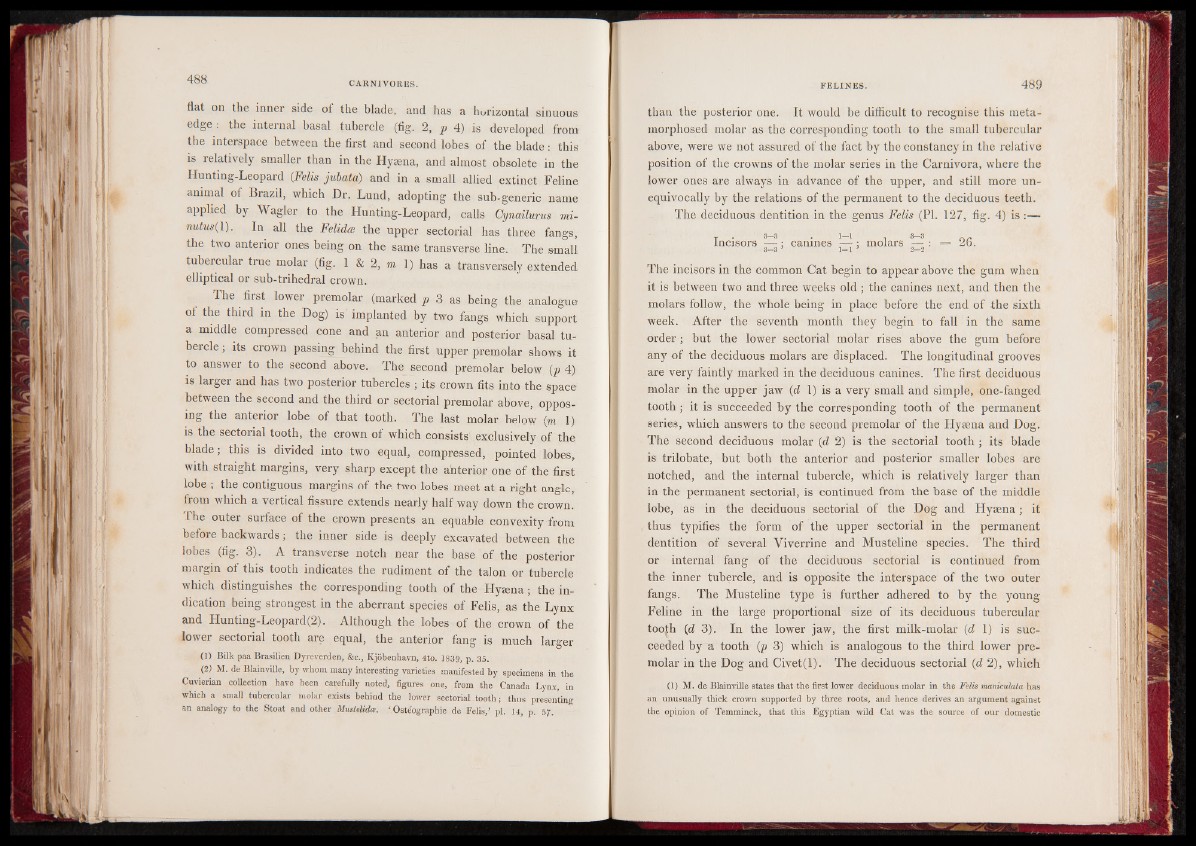
flat on the inner side of the blade, and has a horizontal sinuous
edge : the internal basal tubercle (fig. 2, p 4) is developed from
the interspace between the first and second lobes of the blade: this
is relatively smaller than in the Hyaena, and almost obsolete in the
Hunting-Leopard (Felis jubata) and in a small allied extinct Feline
animal of Brazil, which Dr. Lund, adopting the sub-generic name
applied by Wagler to the Hunting-Leopard, calls Cynctilurus mi-
nutus{\). In all the Felida the upper sectorial has three fangs,
the two anterior ones being on the same transverse line. The small
tubercular true molar (fig. 1 & 2, m 1) has a transversely extended
elliptical or sub-trihedral crown.
The first lower premolar (marked p 3 as being the analogue
of the third in the Dog) is implanted by two fangs which support
a middle compressed cone and an anterior and posterior basal tubercle
; its crown passing behind the first upper premolar shows it
to answer to the second above. The second premolar below {p 4}
is larger and has two posterior tubercles ; its crown fits into the space
between the second and the third or sectorial premolar above, opposing
the anterior lobe of that tooth. The last molar below (m 1)
is the sectorial tooth, the crown of which consists exclusively of the
blade; this is divided into two equal, compressed, pointed lobes,
with straight margins, very sharp except the anterior one of the first
lobe i the contiguous margins of the two lobes meet at a right angle,
from which a vertical fissure extends nearly half way down the crown.
The outer surface of the crown presents an equable convexity from
before backwards; the inner side is deeply excavated between the
lobes (fig. 3). A transverse notch near the base of the posterior
margin of this tooth indicates the rudiment of the talon or tubercle
which distinguishes the corresponding tooth of the Hyaena; the indication
being strongest in the aberrant species of Felis, as the Lynx
and Hunting-Leopard (2). Although the lobes of the crown of the
lower sectorial tooth are equal, the anterior fang is much larger
(1) Bilk paa Brasilien Dyreverden, &c., Kjobenhavn, 4to. 1839, p. 35.
(2) M. de Blainville, by whom many interesting varieties manifested by specimens in the
Cuvierian collection have been carefully noted, figures one, from the Canada Lynx, in
which a small tubercular molar exists behind the lower sectorialJooth; thus presenting
an analogy to the Stoat and other Mustelida. ‘ Osteographie de Felis/ pi. 14, p. 57.
than the posterior one. It would be difficult to recognise this metamorphosed
molar as the corresponding tooth to the small tubercular
above, were we not assured of the fact by the constancy in the relative
position of the crowns of the molar series in the Carnivora, where the
lower ones are always in advance of the upper, and still more unequivocally
by the relations of the permanent to the deciduous teeth.
The deciduous dentition in the genus Felis (PI. 127, fig. 4) is :—
tIn ci• sors 3——3 : can.i nes 1——1 ; mol,a rs 3——3 : = 2o. 3—3 ’ 1— 1 y 2—2
The incisors in the common Cat begin to appear above the gum when
it is between two and three weeks old ; the canines next, and then the
molars follow, the whole being in place before the end of the sixth
week. After the seventh month they begin to fall in the same
order; but the lower sectorial molar rises above the gum before
any of the deciduous molars are displaced. The longitudinal grooves
are very faintly marked in the deciduous canines. The first deciduous
molar in the upper jaw (d 1) is a very small and simple, one-fanged
tooth ; it is succeeded by the corresponding tooth of the permanent
series, which answers to the second premolar of the Hyasna and Dog.
The second deciduous molar (d 2) is the sectorial tooth ; its blade
is trilobate, but both the anterior and posterior smaller lobes are
notched, and the internal tubercle, which is relatively larger than
in the permanent sectorial, is continued from the base of the middle
lobe, as in the deciduous sectorial of the Dog and Hysena; it
thus typifies the form of the upper sectorial in the permanent
dentition of several Viverrine and Musteline species. The third
or internal fang of the deciduous sectorial is continued from
the inner tubercle, and is opposite the interspace of the two outer
fangs. The Musteline type is further adhered to by the young
Feline in the large proportional size of its deciduous tubercular
tooth (d 3). In the lower jaw, the first milk-molar (d 1) is succeeded
by a tooth (p 3) which is analogous to the third lower premolar
in the Dog and Civet(l). The deciduous sectorial (d 2), which
(1) M. de Blainville states that the first lower deciduous molar in the Felis maniculata has
an unusually thick crown supported by three roots, and hence derives an argument against
the opinion of Temminck, that this Egyptian wild Cat was the source of our domestic